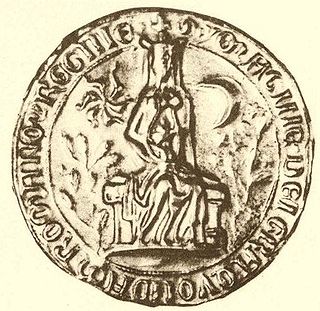
Limburg an der Lahn is the district seat of Limburg-Weilburg in Hesse, Germany.

Adolf was the count of Nassau from about 1276 and the elected king of Germany from 1292 until his deposition by the prince-electors in 1298. He was never crowned by the pope, which would have secured him the imperial title. He was the first physically and mentally healthy ruler of the Holy Roman Empire ever to be deposed without a papal excommunication. Adolf died shortly afterwards in the Battle of Göllheim fighting against his successor Albert of Habsburg.

The County of Isenburg was a region of Germany located in southern present-day Hesse, located in territories north and south of Frankfurt. The states of Isenburg emerged from the Niederlahngau, which partitioned in 1137 into Isenburg-Isenburg and Isenburg-Limburg-Covern. These countships were partitioned between themselves many times over the next 700 years.

Nassau is a town located in the German state of Rhineland-Palatinate. It lies on the lower course of the Lahn River, on the mouth of the Mühlbach, between Limburg an der Lahn and the spa town of Bad Ems, and is located in the Nassau Nature Park, surrounded by the Westerwald to the north and the Taunus to the south. The town is on the German-Dutch holiday road, the Orange Route. As of 2021, it had a population of 4,592.
Otto I of Nassau, German: Otto I. von Nassau was Count of Nassau and is the ancestor of the Ottonian branch of the House of Nassau.
Isenburg-Grenzau was the name of several states of the Holy Roman Empire, seated in the Lordship of Grenzau, in modern Rhineland-Palatinate, Germany. The first state called Isenburg-Grenzau existed 1158–1290; the second 1341–1439; and the third 1502–1664.

Imagina of Isenburg-Limburg was the Queen consort of Adolf of Nassau, King of Germany.

Seck is an Ortsgemeinde – a community belonging to a Verbandsgemeinde – in the Westerwaldkreis in Rhineland-Palatinate, Germany.
Klarenthal Abbey is a former convent of the Order of Poor Ladies in the borough of Klarenthal in Wiesbaden, Germany. Klarenthal is the only abbey in present-day Wiesbaden.
Gerlach IV of Isenburg-Limburg, also known as Gerlach I of Limburg, was from 1258 Count of (Isenburg-)Limburg, ruling over the town of Limburg an der Lahn and some villages in its hinterlands. He was the founder of the short-lived House of Limburg.

John I of Isenburg-Limburg, "The blind Lord" was from 1289 Count of (Isenburg-) Limburg and the head of the House of Limburg. The core territory of the Lordship of Limburg consisted of the city of Limburg an der Lahn and several surrounding villages.
Gerlach V of Isenburg-Limburg, also called Gerlach II "the Elder" of Limburg, was Count of Isenburg-Limburg. He reigned between 1312 and 1355 as Lord of Limburg an der Lahn, and the head of the House of Limburg. The chronicler Tilemann Elhen von Wolfhagen describes him, in his pre-1402 Limburger Chronicle, as a virtuous nobleman and a bright poet in German and Latin.
Gerlach VI of Isenburg-Limburg, also known as Gerlach III of Limburg, was Count of Isenburg-Limburg and Lord of Limburg an der Lahn. He succeeded his father Gerlach V in 1355. In 1356, he married Elisabeth of Falkenstein.

SiegfriedII of Westerburg was Archbishop of Cologne from 1275 to 1297.
John II of Isenburg-Limburg was Lord of Limburg an der Lahn and the last Count of Isenburg-Limburg from 1365 until 1406. He is sometimes designated John III to differentiate him from his non-ruling older half-brother John II.

The Lahngau was a medieval territory comprising the middle and lower Lahn River valley in the current German states of Hesse and (partially) Rhineland-Palatinate. The traditional names of the Gau are Loganahe Pagus or Pagus Logenensis.

Henry I of Nassau-Siegen, German: Heinrich I. von Nassau-Siegen was Count of Nassau-Siegen, a part of the County of Nassau, and ancestor of the House of Nassau-Siegen. He comes from the Ottonian branch of the House of Nassau.

Count Adolf I of Nassau-Siegen, German: Adolf I. Graf von Nassau-Siegen, was since 1384 Count of Diez, through his first marriage. With his brothers, he succeeded his father in 1416 as Count of Nassau-Siegen, and also inherited the County of Vianden in 1417. He descended from the Ottonian Line of the House of Nassau.

The Grenzau Feud was a warlike conflict between the troops of Koblenz in the Electorate of Trier on the one hand and Lord Philip of Isenburg and Lord Reynard of Westerburg on the other at Grenzau on 20 April 1347. The Koblenz soldiers were ambushed and 172 were killed.

The Barony of Westerburg, a small principality around the present day town of Westerburg in the Westerwald mountains of Germany, is first recorded in 1209. The eponymous castle, which had probably been built earlier than when it was mentioned for the first time in 1192, was the family seat of the lords of Westerburg, a branch of the lords of Runkel.













